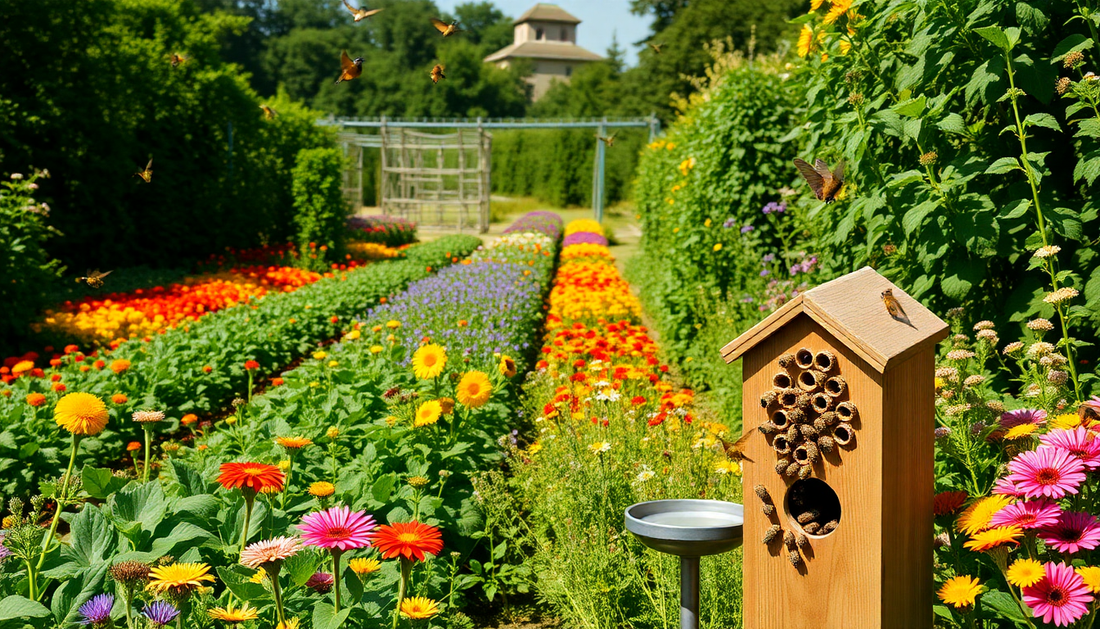
Creating a Pollinator-Friendly Vegetable Garden
Share
In today's world, where environmental concerns are at the forefront, gardeners are increasingly recognizing the importance of creating pollinator-friendly spaces. As we strive to cultivate bountiful vegetable gardens, it's crucial to consider the delicate balance of our ecosystems and the vital role that pollinators play. In this comprehensive guide, we'll explore the steps you can take to transform your vegetable garden into a haven for these essential creatures, ensuring a thriving and sustainable harvest.
Understanding the Importance of Pollinators
Pollinators, such as bees, butterflies, moths, and hummingbirds, are responsible for the reproduction of many of the fruits and vegetables we enjoy. These remarkable creatures transfer pollen from one plant to another, enabling the production of the edible parts we harvest. Without their tireless efforts, our vegetable gardens would be barren and unproductive.
Unfortunately, pollinators are facing numerous challenges, including habitat loss, pesticide use, and climate change. By creating a pollinator-friendly vegetable garden, you can play a vital role in supporting these essential species and promoting biodiversity in your local ecosystem.
Choosing the Right Plants
The foundation of a pollinator-friendly vegetable garden lies in the selection of the right plants. When choosing your vegetable varieties, consider incorporating a diverse array of flowering plants that will provide a continuous source of nectar and pollen throughout the growing season.
Native Plants for Vegetables
Opt for native vegetable varieties that are well-suited to your local climate and soil conditions. These plants have evolved alongside native pollinators, often forming symbiotic relationships that benefit both the plants and the pollinators. Some examples of pollinator-friendly vegetable varieties include:
- Tomatoes
- Squash
- Beans
- Peppers
- Eggplants
In addition to your vegetable crops, consider planting a selection of native flowering plants that will attract a wide range of pollinators. Some excellent choices include:
- Coneflowers (Echinacea spp.)
- Bee balm (Monarda spp.)
- Sunflowers (Helianthus spp.)
- Milkweed (Asclepias spp.)
- Goldenrod (Solidago spp.)
By incorporating these native plants into your vegetable garden, you'll create a vibrant and diverse ecosystem that supports pollinators throughout the growing season.
Companion Planting
Companion planting, the practice of growing different plants in close proximity, can also be a valuable tool in creating a pollinator-friendly vegetable garden. Certain plants can attract specific pollinators or repel pests, while others can provide beneficial nutrients or shade for your vegetables.
For example, planting marigolds or nasturtiums around your vegetable beds can help deter aphids and other garden pests, while also providing nectar and pollen for pollinators. Herbs like lavender, rosemary, and thyme can attract beneficial insects that prey on common vegetable pests.
Sustainable Gardening Practices
Maintaining a pollinator-friendly vegetable garden requires a commitment to sustainable gardening practices. Avoid the use of synthetic pesticides and herbicides, as these can be harmful to pollinators and other beneficial insects. Instead, opt for organic pest control methods, such as introducing predatory insects or using natural repellents.
Additionally, consider leaving areas of your garden untouched, allowing for the natural growth of wildflowers and grasses. These "wild" spaces provide important habitats and overwintering sites for pollinators, ensuring their continued presence in your garden.
Providing Water and Shelter
Pollinators not only need a reliable source of nectar and pollen, but they also require access to water and shelter. Incorporate a shallow birdbath or small water feature in your garden, ensuring that the water is clean and regularly refreshed. You can also create "bee baths" by placing stones or pebbles in a shallow dish filled with water, allowing pollinators to land and access the water safely.
In terms of shelter, consider adding a few bee houses or insect hotels to your garden. These structures provide nesting sites for solitary bees and other beneficial insects, further supporting the pollinator population in your vegetable garden.
Educating and Engaging the Community
Creating a pollinator-friendly vegetable garden is not only beneficial for your own harvest, but it can also inspire and educate your community. Consider sharing your knowledge and experiences with neighbors, local gardening groups, or even schools. Encourage others to adopt similar practices, and work together to create a network of pollinator-friendly spaces throughout your local area.
By taking these steps to transform your vegetable garden into a pollinator-friendly oasis, you'll not only reap the rewards of a bountiful harvest but also contribute to the overall health and resilience of your local ecosystem. Join the growing movement of gardeners who are committed to supporting these essential creatures and ensuring a sustainable future for our shared planet.
Conclusion
Creating a pollinator-friendly vegetable garden is a rewarding and impactful endeavor that benefits both you and the local ecosystem. By carefully selecting native plants, incorporating companion planting, and adopting sustainable gardening practices, you can cultivate a thriving and diverse garden that supports a wide range of pollinators. Remember, every small step you take towards creating a pollinator-friendly space can make a significant difference in the long-term health and resilience of our shared environment.
